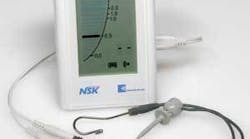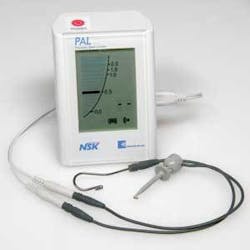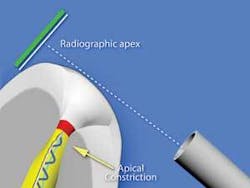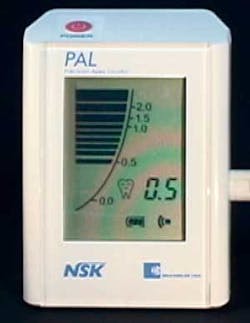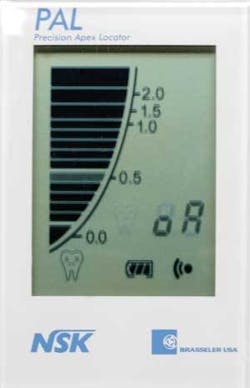By Kenneth Koch, DMD, and Dennis Brave, DDS
One of the quickest ways to build a dental practice is through painless endodontic procedures. While we do not believe that anything is 100 percent certain (with the exception of death and taxes), we can state that endodontics can be performed painlessly 95 percent of the time. One of the keys to painless endodontics is accurate length control. If a clinician instruments outside the confines of the root canal space, this introduces many scenarios - all of which are bad. To further help the clinician determine a final accurate working length measurement, Real World Endo has developed - in conjunction with Brasseler/NSK - a new Precision Apex Locator (PAL) (below).
The concept behind the creation of this particular apex locator was simplicity. “Let’s create an apex locator that is easy to use, reliable, and does one thing and one thing well; tells us where the root canal ends!” The PAL is all about ease and accuracy.
Prior to any determination of working length, it must be understood that the root canal does not terminate at the radiographic apex. Rather, it terminates at the cemento-dentinal junction (sometimes known as the apical constriction), which is usually .5 to .7 mm back from the radiographic apex (below). If you are taking your instrumentation to the radiographic apex, you are long! Oral surgeons and endodontists who do apical surgery witness this routinely when they see gutta percha extruding out the end of a tooth that, on an X-ray, shows the gutta percha (seemingly) terminating at the physical end of the root (radiographic apex). This confusion about where the root canal ends is further complicated by institutions that continue to teach their students to instrument to the end of the tooth, as well as by some apex locators that show “Apex” on their screen. Many clinicians misinterpret this term and, in fact, set their working length to “Apex,” which is, in reality, the physical end of the tooth. It is little wonder that we often hear the complaint, “I am still getting bleeding.” Of course you’re getting bleeding! You have instrumented long (beyond the canal space) if you have instrumented to the radiographic apex.
The Precision Apex Locator is compact, stable, and easy to use. More importantly, it has been developed with technology sophisticated enough that there is only one button to push on the unit. The PAL is so sophisticated, it’s simple.
As previously mentioned, this unit does only one thing - but it does that one thing extremely well. It tells you exactly where the root canal ends, not where the tooth ends! The PAL has a gradient bar readout (LCD) that is calculated in tenths of millimeters. Consequently, as one progresses down the root canal, the reading on the screen likewise moves in an apical direction. However, the readout display on the PAL is very different from that of other apex locators. We have designated 0.0 (zero) as the end of the root canal space, not the end of the tooth. Furthermore, as one gets closer to the terminus (within 0.5 mm), a Happy Tooth is illuminated on the screen. When the file progresses into this area (0.5 - 0.0 mm), the clinician has entered the Zone of Precision (below).
Establishing a working length anywhere within this zone will work well as a final working length. The clinician may establish a working length anywhere from 0.1 mm to 0.5 mm back from the cemento-dentinal junction and it will work fine clinically because the PAL has been specifically designed to be used with rotary files. Frequently, as the result of file design and clinical techniques, rotary files go a little further down the canal than the doctor intends. However, by establishing a working length anywhere within the Zone of Precision, the doctor performs an instrumentation technique that is confined to the root canal space.
When using a hand file to determine final working length, if it goes past the end of the root canal, this is seen on the LCD screen as the bar going past 0.0. In fact, if the canal length is exceeded (past 0.0), an Unhappy Tooth illuminates on the screen. However, some clinicians prefer to go a little long (less than .5 mm), confirming apical patency with the hand file (illuminating the Unhappy Tooth) and then they pull back into the canal (below).
The Precison Apex Locator is self-calibrating and uses multiple frequencies to determine the working length. There is no need to remove probes and reactivate the unit. Moreover, it is generally not necessary (to obtain an accurate measurement) to extend the file past the end of the canal and then pull back into the canal. Simply go down the canal until you reach the Zone of Precision and choose a position close to 0.0 that will work well for you clinically. Again, the end point that is chosen as a final working length is somewhat influenced by your rotary technique. As your experience with rotary instrumentation grows, the more control you will have over the files. Ultimately, you can set your final working length to 0.0 and manage that length in a consistent manner, without fear of going long.
Similar to most apex locators, the PAL has an audio component. The alarm sound can be set at one of three volume levels - high, medium, or low. A simple push of the alarm key on the back of the unit will adjust the volume to the desired level. Following the adjustment of the alarm key on the back of the unit, the alarm mark on the LCD screen changes accordingly.
This unit uses four AAA batteries and can operate continually for approximately 50 hours. Also, as an energy-saving function, the unit automatically shuts down after 10 minutes when not in use.
Clinical troubleshooting
Premature readings
Generally, a premature reading is a combination of two things. It usually involves a large canal such as a distal canal in a lower molar or a palatal canal in a maxillary tooth. Secondly, there is very inflamed tissue (hyperemia) involved. There are two ways to correct this situation.
- Do what endodontists do; remove as much of the inflamed tissue as possible from the canal before inserting the file and using the apex locator. This often means removing as much as two-thirds of the canal contents.
- Simply use a larger file such as a #25 Hedstrom in the large canal instead of a #10 K file.
Another example of a premature reading can occur when a machine reads that the apex has been reached when, in fact, it is considerably short of the cemento-dentinal junction.
The latest generation of apex locators will “read” large lateral canals so the clinician must be aware of the occasional reading that “seems short.” For example, maxillary canines are generally 25-27 mm in length. If the apex locator signals 0.0 at 21 mm, you must be aware that it is, in most likelihood, reading a large lateral canal. Simply reposition the file to continue past that point in the canal and you should get a true working length determination deeper in the root canal.
Inconsistent or erratic readings
What are the two most common causes of an erratic reading?
- When the pulp chamber is not kept dry and clean. Any fluid in the chamber or metallic debris can contaminate the readings of the individual canals. Always keep the canals moist and lubricated but the pulp chamber dry and free of metal shavings. Failure to do so will result in erratic readings.
- Where the access is insufficient and the K file used to gain working length rubs against the crown or amalgam wall. This metallic connection will short circuit the readings.
Summary
In this article, we have introduced you to a new precision apex locator (PAL) that will make your working length determination a straightforward procedure. This unit has been designed to be simple and accurate. As you do more and more endodontic procedures, with precision, it will become apparent that one of the keys to painless endodontics lies in consistent and accurate length control. It is very important to confine our shaping procedures to the confines of the root canal space and not to instrument long. All practitioners should take advantage of the technology available to determine a precise working length. Your patients will appreciate it!
Dr. Dennis Brave is a diplomate of the American Board of Endodontics and a member of the College of Diplomates. In endodontic practice for 27 years, he was the senior managing partner of a group specialty practice. Dr. Brave, formerly an associate clinical professor at the University of Pennsylvania, currently holds a staff position at The Johns Hopkins Hospital. Dr. Kenneth Koch is the founder and past director of the program in postdoctoral endodontics at the Harvard School of Dental Medicine. In addition to having maintained a private practice limited to endodontics, he has written numerous articles on endodontics and maintains a faculty position at Harvard. They can be reached at Real World Endo at (866) 793-3636 or through www.realworldendo.com.
